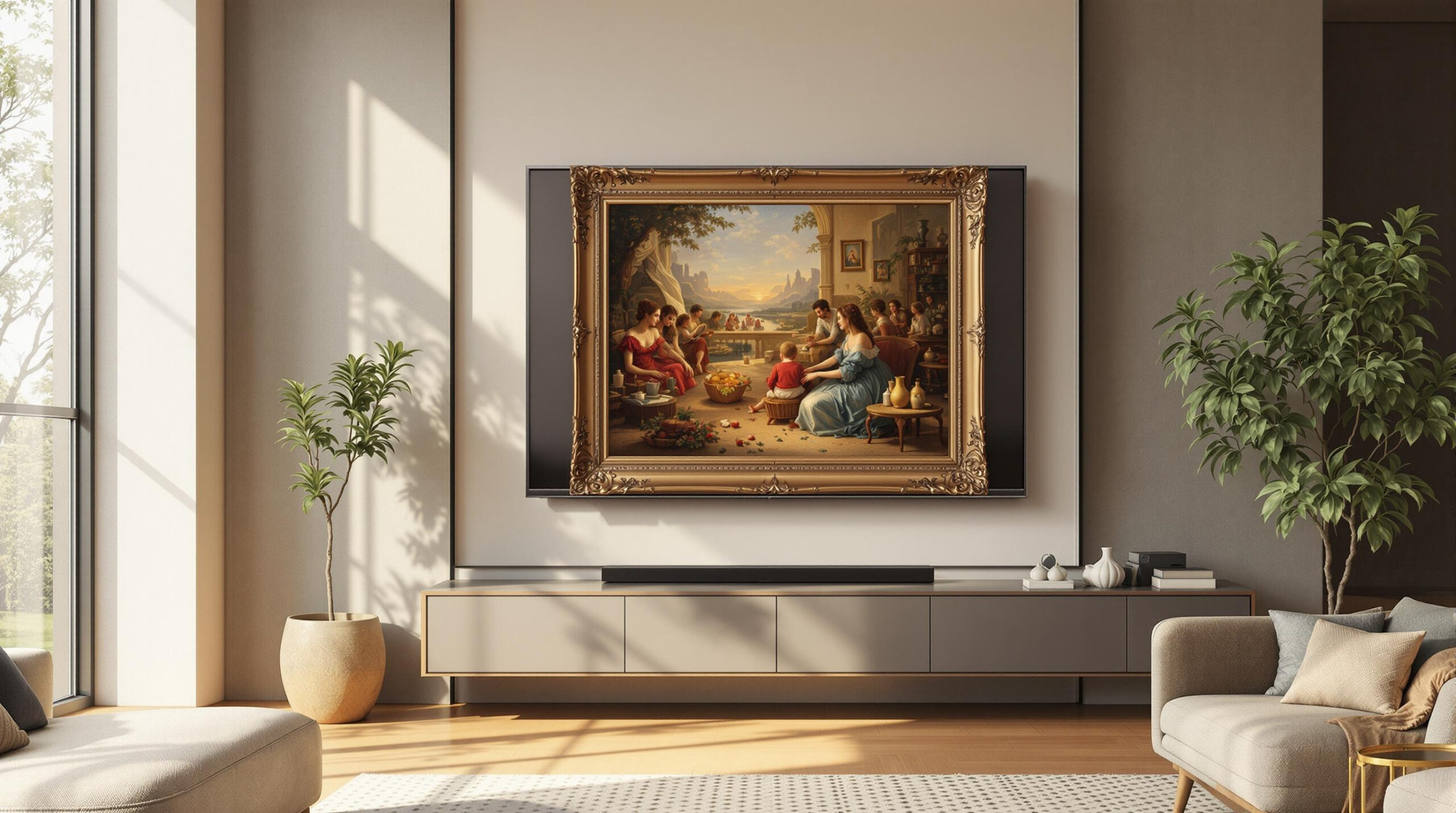Introduction: From Blank Screens to Dynamic Living Spaces
In the not-so-distant past, a turned-off TV was nothing more than a black rectangle in the middle of your living room. It sat idle, reflecting light and collecting dust until you turned it back on. But in 2025, the television has transcended its traditional role. Thanks to the latest innovations in ambient mode and screensaver technology, today’s best LED TVs offer more than just brilliant entertainment—they transform your space, express your style, and remain visually relevant even when the show is over.
Ambient Mode is more than a gimmick. It’s a feature that combines design intelligence, smart software, and advanced panel technology to let your television blend into the room or stand out with purpose. Whether you’re displaying art, personal photos, dynamic lighting effects, or real-time weather data, the TV becomes a vibrant part of your decor, not just a passive display. Screensaver features, once simple slideshows, have evolved into AI-curated galleries, interactive data streams, and motion-synced visualizers that breathe life into your environment.
This article explores the best LED TVs with Ambient Mode or advanced screensaver features available in 2025. It dives into the artistic, technical, and lifestyle benefits of these features while showcasing the top-performing models that offer truly immersive off-screen experiences. If you’ve ever wanted a TV that disappears when not in use—or turns your wall into a museum, portal, or weather window—this is your essential guide.
The Philosophy of Ambient Mode: Redefining the Purpose of a Screen
Ambient Mode isn’t just about filling blank space. It’s about giving the screen a role beyond media consumption. Modern living spaces demand flexibility and integration, and the best Ambient Mode-equipped LED TVs meet those needs beautifully. They turn a passive surface into an adaptive visual asset that responds to your environment, your preferences, and your daily rhythms.
Whether you want to display tranquil animations during downtime, mimic the wall color behind the panel to make it “disappear,” or showcase a rotating set of fine art with museum-style lighting, Ambient Mode enables the television to serve as a dynamic design element. It also eliminates the aesthetic burden of a black screen and allows you to personalize your interior while the TV is on standby.
Leading brands like Samsung, LG, Sony, and TCL have embraced this philosophy in different ways—each creating proprietary systems that turn their LED TVs into lifestyle-enhancing devices, not just entertainment hubs. The result is a new generation of displays that are always on, always aware, and always aesthetic.
Samsung’s The Frame and Neo QLED Series: Masters of Disappearing Displays
No conversation about ambient mode is complete without Samsung. The company revolutionized the category with The Frame, a television that masquerades as framed art when not in use. In 2025, the latest iteration of The Frame delivers not just a QLED panel with lifelike color and deep contrast, but a nearly matte, anti-reflective surface that eliminates glare and mimics the look of canvas.
Samsung’s Ambient Mode+, also available on its premium Neo QLED series like the QN90D and QN85D, enables users to blend the TV into the background, display weather widgets, headlines, calming animations, or personal photos with elegant transitions. The TV can use the SmartThings app to detect the wall pattern or color behind it and render a matching texture—literally making the screen vanish when idle.
With ultra-thin bezels, customizable magnetic frames, and motion sensors that wake the screen only when you’re in the room, Samsung’s ambient display technology is the most refined on the market. These features not only save energy but enhance living spaces with elegance and personalization. From Van Gogh paintings to minimalist motion graphics, the QLED and Frame TVs bring high art and high tech together in stunning harmony.
LG’s Gallery Design and Always Ready Mode: Subtle Sophistication Meets Smart Display
LG has taken a slightly different but equally compelling approach with its QNED and Gallery Series LED TVs. The 2025 LG QNED90T, for instance, features “Always Ready” mode, which allows users to transform the TV into an intelligent art display or information dashboard when it’s not actively playing content.
This mode allows for animated art, static visuals, curated albums from your Google Photos or smartphone library, and AI-generated backdrops that sync with ambient lighting. Thanks to LG’s webOS smart platform, the interface for these features is fluid, customizable, and effortlessly modern. The Magic Remote and voice control features make navigating ambient content seamless, letting you change styles or themes without leaving the couch.
What sets LG apart is its OLED-inspired design sensibility applied to LED technology. The Gallery Design aesthetic ensures ultra-thin panels that mount flush against the wall, eliminating bulk and making ambient displays appear as though they’re truly part of the wall itself. When paired with Dolby Atmos sound and mood lighting, LG’s ambient features become a multi-sensory experience that adds depth and serenity to any space.
Sony’s BRAVIA XR and Art Mode: Engineered for Atmosphere
Sony brings its signature image processing brilliance to ambient displays through its BRAVIA XR series, which now includes Art Mode and Living Decor functionality. While Sony may be more subtle than Samsung in branding its ambient features, the execution is undeniably elegant. With XR Cognitive Processor-driven image rendering, every piece of displayed content—be it fine art, family portraits, or animated scenery—feels rich and layered.
Sony’s 2025 BRAVIA LED models offer screensaver functionality that automatically adapts to lighting conditions using integrated light and color sensors. This results in visuals that remain consistent regardless of day or night lighting, creating a natural blend with your space. The system can also pull personalized content from cloud libraries, Google Photos, or live feeds, ensuring you always have a reason to look at the screen—even when not watching traditional content.
In addition, Sony’s BRAVIA CAM can detect when you walk into the room and automatically activate ambient content. This intelligent integration turns your TV into a presence-aware visual assistant, reinforcing the idea that screens can be beautiful and purposeful at all times.
TCL and Hisense: Budget-Friendly TVs with High-End Screensavers
In 2025, TCL and Hisense have risen to prominence for offering premium features at mid-range prices, and ambient mode is no exception. TCL’s Google TV-powered models and Hisense’s ULED lineup include customizable ambient screensaver features that go beyond static image display.
These brands offer Google Photos integration, day/night sync modes, and the ability to use music visualizers or smart home dashboards as screensavers. Hisense U8N, for example, supports AI-generated ambient loops, displaying flowing natural scenery, digital clocks, and even interactive calendars or weather updates with high brightness and excellent local dimming contrast.
While not as artistically focused as Samsung or LG, TCL and Hisense aim to maximize functionality and customization. Users can upload content, stream ambient playlists from YouTube, or install third-party screensaver apps for infinite personalization. And thanks to Mini-LED and Quantum Dot technology, even non-video visuals look dynamic and colorful.
These brands are ideal for consumers who want the benefits of ambient features without paying flagship prices. They may not replicate a painting, but they do turn your screen into a useful and pleasant visual fixture that adapts to your lifestyle.
The Technical Side: Why LED is Ideal for Ambient Displays
Many users wonder whether OLED is superior for ambient displays due to its deep blacks and self-lit pixels. While OLED indeed offers excellent contrast, LED TVs—especially those with Mini-LED and full array local dimming—are actually more suitable for extended ambient use for a critical reason: burn-in resistance.
Static images, like photo borders, clocks, and UI elements, can cause image retention on OLEDs over time. LED TVs, on the other hand, use backlit LCD panels that do not suffer from this issue. This makes LED the preferred choice for users who want their TVs on throughout the day displaying still or looping ambient content.
Furthermore, LED TVs often achieve higher sustained brightness, especially in sunny rooms or open-concept spaces. This allows Ambient Mode visuals to retain clarity and vibrancy, even during daylight hours. With adaptive brightness controls, LED TVs can scale visuals to suit changing conditions, making them more practical as all-day ambient surfaces.
The color volume and efficiency of Quantum Dot technology also lend themselves beautifully to art and screensaver displays. Colors appear more saturated at high brightness levels, and power consumption remains relatively efficient compared to OLED when displaying bright content consistently.
Smart Integration and Voice Control: Making Ambient Effortless
Another key feature that enhances Ambient Mode functionality is smart assistant integration. All major TV brands now support Google Assistant, Amazon Alexa, and Apple AirPlay, allowing you to activate ambient features using simple voice commands.
Want to display your latest vacation photos? Say the word. Need a serene sunset animation to accompany your evening music? Just ask. Want your TV to act as a calming focal point during meditation? These systems now support guided visualizations, breathing patterns, and mood lighting controlled by your voice or synced with your smartphone or wearable.
Voice recognition also lets you toggle between ambient profiles for different times of day. Morning settings can include calendars, weather, and productivity visuals, while evening profiles bring in warm tones, artwork, and calming loops. The TV essentially becomes a visual extension of your lifestyle, adapting automatically based on routines, preferences, or commands.
Interior Design Meets Digital Display: A Lifestyle Upgrade
Beyond the technology, the biggest reason Ambient Mode matters is lifestyle. These TVs allow you to marry form and function, creating spaces where the screen enhances rather than interrupts the aesthetic. Whether you live in a minimalist loft or a classic home filled with art, a TV with Ambient Mode complements your interior design.
Design-conscious homeowners no longer have to compromise between technology and decor. TVs like The Frame offer customizable bezels that match your walls or furniture. LG’s Gallery Series can sit flush against the wall like a true art piece. Sony BRAVIA displays can match ambient lighting to extend color themes beyond the frame, creating a unified visual palette in the room.
As TVs become larger and more central in home design, Ambient Mode ensures they remain beautiful, contextual, and intelligent—even when turned “off.”
Conclusion: Screens That Do More Than Entertain
The evolution of LED TVs in 2025 has delivered far more than higher resolutions and better contrast. It has redefined what a television can be when it’s not playing a movie or showing a game. The best LED TVs with Ambient Mode and advanced screensaver features are transformative design elements, combining powerful visuals with personalization, intelligence, and style.
Whether you’re displaying your photography, cycling through curated artwork, setting a calming tone with animated landscapes, or simply blending your TV into the wall with color-matched backgrounds, these TVs enhance your space, reflect your personality, and adapt to your needs.
Ambient Mode is no longer a novelty—it’s the future of television utility. And with options from Samsung, LG, Sony, TCL, and Hisense, there’s never been a better time to choose a screen that’s as beautiful when it’s idle as it is when it’s on.
LED/LCD TV Reviews
Explore Philo Street’s Top 10 Best LED/LCD TV Reviews! Dive into our comprehensive analysis of the leading OLED TV products, complete with a detailed side-by-side comparison chart to help you choose the perfect protection for your devices.




